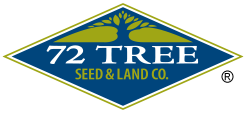Notice: Undefined variable: page in /home/vrxdg1855sn3/public_html/wp-content/themes/72tree/content.php on line 15
Notice: Trying to get property 'ID' of non-object in /home/vrxdg1855sn3/public_html/wp-content/themes/72tree/content.php on line 15
Preventing and Eliminating Christmas Tree Bugs
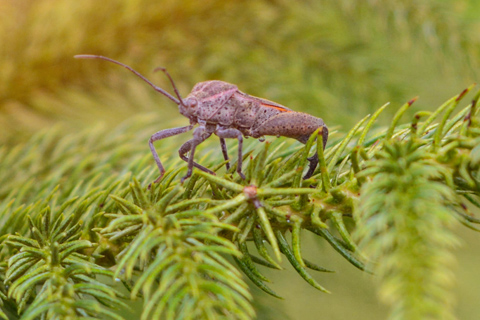
The Christmas tree is the pinnacle of holiday decorating but can also be a nightmare when bugs hitch a ride on the tree into your home.
Infested Christmas trees present a series of problems for the homes and neighborhoods they decorate. Pest control and prevention are essential measures when putting up a live tree for the holidays.
72tree.com collected information on the bugs that can be found on Christmas trees, how to prevent the buying of an infested tree, eliminating any insects found on the tree, and how to properly dispose of the tree.
Bugs on Christmas Trees
When you go to your local Christmas tree lot, keep in mind that just a few days prior, those trees were cut down from a Christmas tree farm or a forest.
Insects may have nested in or laid eggs on these trees. The following are some of the insect species you may encounter living or hatching in your Christmas tree:
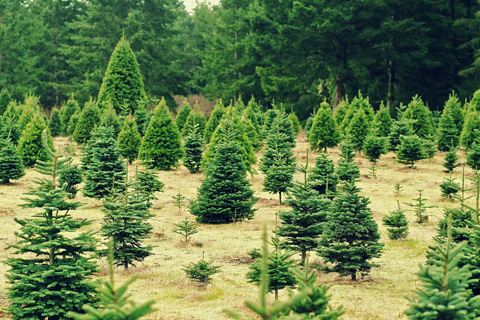
• Aphids
• Spiders
• Bark Beetles
• Mites
• Scale
• Needle Scale
• Mantises
• Spotted Lanternflies
• Sawfly
• Adelgids
• Stink Bugs
Note: Store-bought wreaths and swags made from live tree stems may travel thousands of miles from where they originated (potentially exposing your ecosystem to a new or invasive insect species). During the manufacturing and packing processes, bugs and the eggs they lay can easily be overlooked.
How To Prevent Bugs on your Christmas Tree
You can prevent bringing bugs into your home on a Christmas tree by following a few easy steps:
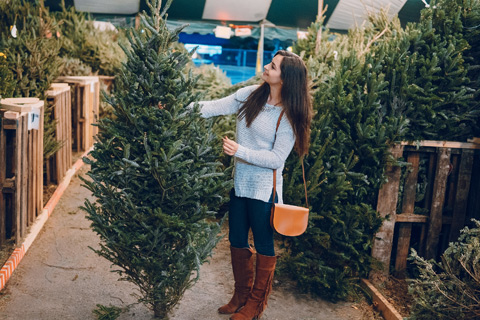
Right Time to Shop – Do not shop for a Christmas tree at night. It is easier to spot insects and eggs during the daytime.
Inspect the Under Side of Branches – Lay the tree down and get an up-close look at the underside of the branches and the trunk. Pay particular attention to the lower branches. You are looking for:
• Visible Insects
• Red or Brown Dots (Mites)
• Clusters of Eggs (Mantises and Lanternflies)
• What Appear to Be Snowflakes (Adelgids)
• White or Red Dots on Needles (Scale)
• Brown Cocoons (Sawfly)
• Small Holes in Trunk (Bark Beetle)
• Sawdust Trails (Bark Beetle)
Let It Stand – Attach the base and let the tree stand in the garage for a day or two. As a preventative measure, apply neem oil or insecticidal soap to the tree before moving it inside and decorating it.
How To Get Rid of Christmas Tree Insects
One of the most common insects found on Christmas trees is aphids. Killing aphids and other insects can be accomplished by spraying the tree with non-toxic neem oil or a homemade insecticidal soaps. Read more about killing aphids.
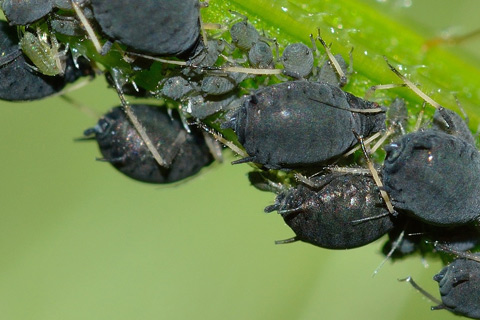
For the most part, newly hatched insects and spiders quickly expire from desiccation (they dry out). However, there are those that do survive.
Beetles, mantises, spotted lanternflies, and sawflies can leave the tree and potentially make their way outside. Again, the application of neem oil and insecticidal soap can be used to control these insects.
If you spot insects or eggs on your tree, DO NOT use commercial aerosol bug sprays. There is no necessity to expose yourself and your loved ones to these harsh chemicals. And, as many of them are flammable, you risk having the tree and your home go up in flames.
For pests that have fallen to the floor or are on your furniture, avoid stepping on them or crushing them (they can leave stains, and some insects have a putrid smell).
Use a vacuum cleaner that doesn’t have a beater bar to suck them up. Then treat the bag or the receptacle with neem oil or insecticidal soap before disposing of them.
How To Dispose of a Christmas Tree
To help preserve the ecosystem in your region, avoid placing the used tree on brush piles or compost heaps. Invasive insects and diseases are able to escape into landscapes and neighboring forests, becoming established, and upsetting the native ecosystem.
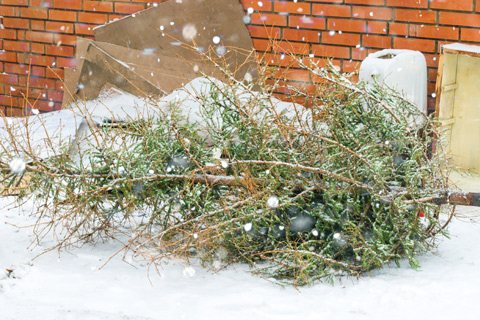
When you take steps to properly purchase, treat, and dispose of a Christmas tree, these risks are dramatically reduced.
Many municipalities and counties nationwide have pickup programs established to retrieve your tree at curbside and properly dispose of it.
If you miss this service or it isn’t available, you can take the tree to a solid waste facility, dump, or landfill. This will keep any pests that may remain in the tree from spreading.
Bug-Free Christmas Tree for the Holiday Season
An infested Christmas tree inside your home probably wasn’t on your wish-list for this holiday season. When bugs hitch a ride into your home, you need to know how to handle them efficiently.
From this article, you have discovered which bugs can be found on a Christmas tree, what to look for when purchasing the tree, how to eliminate any bugs on the tree, and how to properly dispose of the tree once the season is over.
Your home, neighborhood, and neighboring forest are all at risk when the poor management of a Christmas tree infestation allows foreign or invasive insects to disrupt a native ecosystem. Pest control and prevention should be one of the main concerns of a live tree in your home for the holidays.
Sources:
https://hortnews.extension.iastate.edu/insects-christmas-trees
https://christmastrees.ces.ncsu.edu/badbugs/
https://extension.unh.edu/resources/files/resource000986_rep2299.pdf
https://aces.nmsu.edu/ces/yard/2000/122300.html
Notice: Undefined variable: page in /home/vrxdg1855sn3/public_html/wp-content/themes/72tree/content.php on line 15
Notice: Trying to get property 'ID' of non-object in /home/vrxdg1855sn3/public_html/wp-content/themes/72tree/content.php on line 15
Killing Aphids
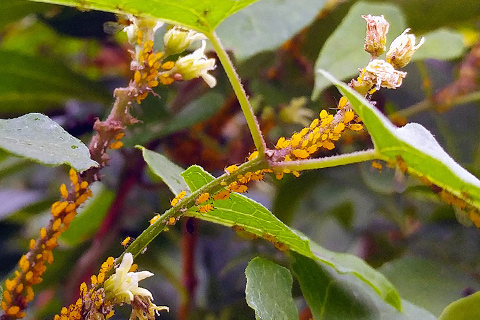
Disgusting aphids are a severe problem that can destroy your landscape. During an infestation, what appears to be a black tar on your foliage is actually a fungus growing in aphid excrement. The more of this you see, the bigger your problem is.
Aphids can cause the eventual death of your plants and trees, both indoors and outdoors. Upon detection of an infestation, treatment should begin immediately, and only end when all signs of the pest are gone.
In this article, 72tree.com answers some common aphid questions, and offers three easy methods to control them.
How to Get Rid of Aphids
Getting rid of your aphid problem starts with observing how big of a problem you have, determining which actions to take, and following up to ensure the problem is over.
Observation – In many aphid infestations, you may notice the presence of ants. These ants are not attacking the aphids, they are cultivating the honeydew excrement which they produce.
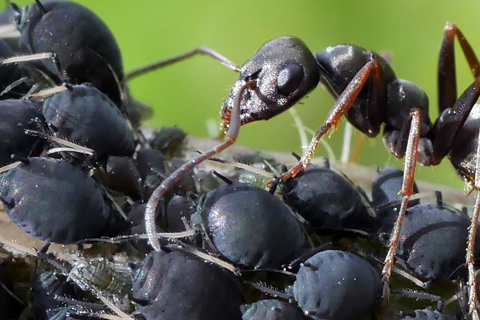
If this is the case, locate the ant trail(s) and treat the ant problem simultaneously with the aphid problem. You will see below that these three treatments work well for both insects.
Action – The following are 3 simple solutions that eliminate aphids without the use of commercial insecticides.
1 – Insecticidal Soap – The ingredients are:
• Liquid dishwashing soap (Dawn, Ivory, etc. but not the special formula varieties)
• Vegetable oil (corn, canola, sunflower, etc.)
• Warm water (filtered or soft water)
Step 1 – Mix 1/2 cup of vegetable oil with 3 Tbsp of dishwashing soap in a measuring cup and mix well.
Step 2 – Pour the mix into an empty (clean) gallon container and fill it halfway with warm water.
Step 3 – Shake the mixture well and fill a spray bottle with it. Keep the remainder of the mixture in a cool, dry place until the next use.
Application – In the early morning or late afternoon, spray the mixture directly on the aphids and ants (if present), you will also spray the area around the infestation, and along the ant trails.
Apply the mixture weekly in the same way for three weeks, or until the pests are eliminated.
2 – Neem Oil – Neem oil is a pungent vegetable oil derived from the fruit and seeds of an evergreen tree called Neem.
Pure Neem oil can be purchased at your local gardening center and comes ready for use.
Application – Again, in the early morning or late afternoon, spray the oil directly on the aphids and surrounding areas.
When sprayed along ant trails, Neem oil is very effective in repelling many species of ants. This is accomplished by disrupting the pheromone trails ants leave for others to follow.
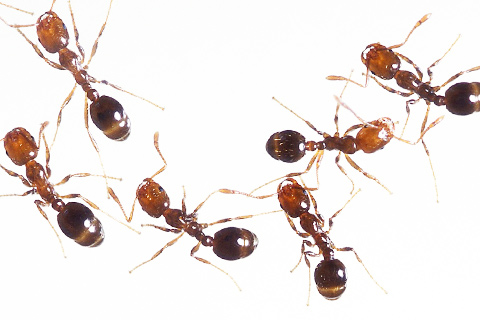
Apply on a weekly basis until the ants and aphids are no longer visible.
3 – Vinegar Spray – The ingredients are:
• Vinegar (white or apple cider)
• Water
Step 1 – Mix equal parts of vinegar and water together in a spray bottle.
Application – In the early morning or late afternoon, spray the water and vinegar mixture directly on the infestation and surrounding area.
When sprayed in the affected area and along the ant trail, this solution works well to repel the ants and disrupt their pheromone trail.
Apply weekly until the infestation has been eliminated.
For treating other insect infestations, visit this link https://www.72tree.com/using-dormant-horticultural-oil-treat-tree-insect-infestations/
People Also Ask
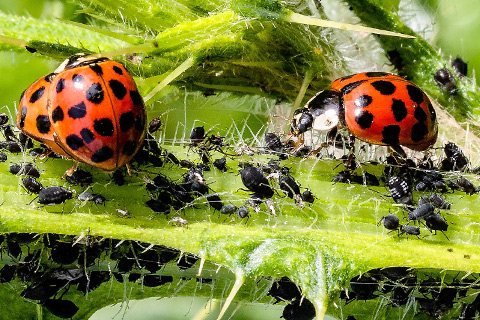
Q: Why Do You Apply Insecticides in the Morning?
A: Insecticides and insect deterrents are applied in the early morning or late afternoon to avoid overheating the foliage in direct sunlight.
Q: How Long is the Life of an Aphid?
A: Depending on the species and environment, aphids live from one week to forty days.
Q: How Long Do Aphid Infestations Last?
A: As aphids are able to reproduce rapidly, infestations can occur relatively quickly and may last until the death of the host (without treatment).
Q: What Insects Eat Aphids?
A: The most beneficial predatory insect of aphids is the ladybug. Plant marigolds, sunflowers, dill, and daisies to attract ladybugs, lacewings, and other beneficial insects. Also, consider buying and releasing ladybugs directly into your garden.
Q: Do Ants Eat Aphids?
A: No – Ants cultivate and eat aphid excrement (called honeydew) which is produced after the aphids consume the sap from plant and tree foliage.
Q: What Is the Black Film All Over the Leaves?
A: During an aphid infestation, the black tar-like substance on the foliage is actually a fungus known as “sooty mold” growing in the honeydew (aphid excrement).
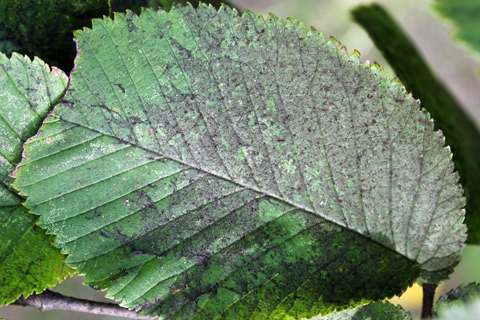
Keep Your Landscape and Home Aphid Free
With the ability to quickly multiply and infest your landscape, aphids can cause the decline and eventual death of your plants and trees.
In this article, we’ve answered common “aphid” questions, you’ve learned to identify an aphid infestation and take action. You now know how to use three effective control methods and how to attract beneficial insects to your landscape.
By not taking action against an aphid infestation, you are leaving your plants and trees vulnerable to other insect infestations and disease which can kill them even faster.
Sources:
https://www.pestworld.org/news-hub/pest-articles/six-steps-to-an-ant-free-home/
Notice: Undefined variable: page in /home/vrxdg1855sn3/public_html/wp-content/themes/72tree/content.php on line 15
Notice: Trying to get property 'ID' of non-object in /home/vrxdg1855sn3/public_html/wp-content/themes/72tree/content.php on line 15
My Neighbor’s Tree Fell on My House, Now What?
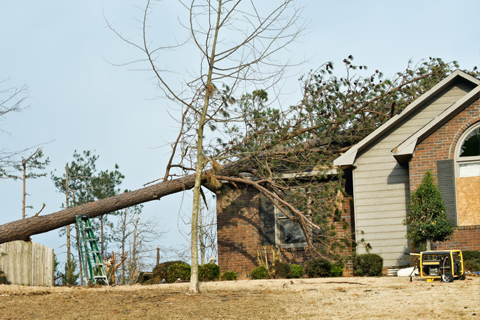
When your neighbor’s 100-foot tree crashes down onto your house, there is much to be done to get life and your home back to normal. When the adrenaline and nerves settle, you’ll need to know what to do next to quickly and safely resolve the situation.
Within greater Atlanta, trees fall pretty frequently. When one lands on a house, immediate action must be taken to prevent further damage and determine who is responsible.
Neighbor’s trees that have fallen on homes is something 72 Tree service has had more than 45 years of experience in mitigating, and in this article lay out exactly the steps and factors you should consider.
What To Do When Your Neighbor’s Tree Falls on Your House
Similar to a fire or flood, it should be treated as an emergency when a tree crashes down on your home. Fast action is required, and the following steps will help you keep everyone safe while getting your home and life back to normal:
1 – Evacuate the property! Get everyone (including pets) out of the house. Gas, water lines, and electrical systems can be severely damaged creating a fire, explosion, or electrocution hazard.
If the tree damaged any vital home systems, and it is not safe to return to the home, get your loved ones to a safe location until after the repairs.
2 – Call 9-1-1 or Respective Emergency Services, to report the incident if your neighbor’s tree:
• Inflicted any injuries or caused any fatalities
• Crossed power lines or damaged utilities before falling on your home, or
• Threatens pedestrians or is blocking the flow of traffic
In such cases, an emergency dispatcher is able to mobilize Medical Services, utilities, a power company unit, or other necessary departments to ensure your and the public’s safety.
Visit 72tree.com/power-line-interfering-trees-city-alpharetta-ga-ordinance/ for non-emergent interfering power lines.
3 – Turn the power off immediately if you smell gas, or water is coming through the roof or from broken pipes. Next locate and turn off the gas and/or water main.
This is a dangerous situation because a spark can cause an explosion from a gas leak, or you could be electrocuted if water comes in contact with live electrical wires.
4 – Document everything that is taking place! Take pictures of the tree and all related damages. This will help you in supporting your case and recovering your settlement when filing an insurance claim.
5 – Contact your homeowner’s insurance provider to report the situation, and follow their instructions (not doing so will potentially void your policy).
6 – Contract a 24-hour emergency tree removal company and certified arborist to remove the tree, and assess whether or not the tree was diseased, dead or dying before it fell.
Depending on the location of the fallen tree and degree of difficulty in accessing it, be sure to contract a tree service that has the skills, experience, tools and equipment (bucket truck, crane, etc.) to get the job done efficiently and safely.
Watch this Roswell removal team to see the correct process of using a crane to remove a fallen tree.
7 – Contract a 24-hour roofing company to inspect damages, tarp, and repair or replace your roof.
8 – Contract a 24-hour plumber if you have any visible leaks or broken pipes that must be repaired. Otherwise, during regular hours contact a plumber to examine your home’s plumbing system for any unseen or concerning collateral damage.
This is an essential step. The jolt of a tree crashing into your home has the potential to disturb and damage the plumbing throughout, and even on the opposite side of the house.
9 – Contract a 24-hour emergency water removal company if water is flooding your home from a storm or broken pipe(s). It is a top priority to cleanup and extract any water from causing further structural damage, or causing a future issue with mold.
What You Need To Know If Your Neighbor’s Tree Falls on Your House
Your House – When your neighbor’s tree falls on your house, there will be apparent damages to the landing area. This type of impact will typically result in hidden structural, electrical, and plumbing problems throughout the house.
Your Neighbor’s Tree – The state of the tree before it fell is of the utmost importance, and the following scenarios will illustrate why:
Scenario #1 (Your Liability) – If your neighbor’s tree was healthy and thriving when it was uprooted, broken, or blown over by severe weather, it is your own homeowner’s insurance policy that will cover damages to your home.
Scenario #2 (Their Liability) – If it is determined and documented by a certified arborist that your neighbor’s tree was diseased, dying, or dead when the event occurred, your neighbor may be held fully responsible for all damages when the following conditions are true:
• In the State of Georgia, the tree owner can be held liable for damages and injuries resulting from the tree’s falling, only if he or she had preexisting knowledge of the tree being dead, dying, or diseased. If there were no apparent reasons for concern (no visible signs of trouble) or no documentation stating otherwise, the tree owner (your neighbor) could not be considered at fault.
• When it can be proven in written form that an arborist, neighbor, tenant, city employee, or other third party identified and reported to the neighbor the existence of a problem before the tree fell, this constitutes preexisting knowledge on the part of the tree owner.
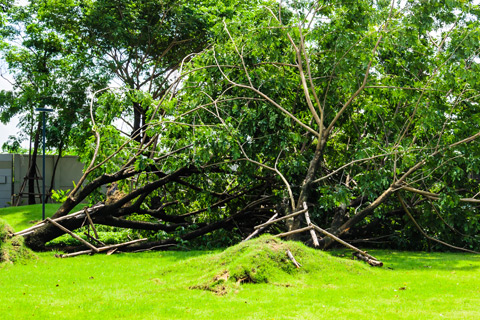
Adjacent Trees – When a tree is uprooted during a storm, be cautious of the trees close to it. Trees growing close together will often rely on each other’s roots to anchor themselves, and when one of those trees falls, the trees around it may become destabilized and fall as well.
The Insurance Company – Some insurance policies can be complicated and confusing, but if the tree damaged a structure on your property – once you have met your deductible and have not exhausted the total coverage limits of your policy – your insurance provider may be liable to pay for damages up to your coverage limits.
The emergency removal company you contract should specialize in large loss claims, and support your efforts in working with your insurance company. 72 Tree has successfully mitigated insurance claims for over 45 years, working with most platinum insurance companies and insurance adjusters to quickly return your life and home to normal.
Your Home, Emergency Tree Removal, Insurance, and Repairs
Knowing what to do when your neighbor’s tree falls on your home will help you focus on what needs to get done vs. who is to blame. Being able to mobilize the right services quickly will help keep stress levels under control, and allow you to get on track to returning life to normal.
Once your neighbor’s tree (or any tree for that matter) falls on your home, fast action is essential. Move your loved ones to a safe location, call 9-1-1 if needed, and contact your homeowner’s insurance provider. Then, contract a trusted emergency tree removal company, a roofing company with a contractor that can inspect the home’s entire physical structure for collateral damages, and a plumber to look for and repair any pipe ruptures or hidden leaks from the impact.
When your neighbor’s tree falls on your home, protect yourself and your assets by taking swift action. Delays or procrastination can become costly problems, potentially voiding your homeowner’s insurance policy while exacerbating damages to your home and property.
Sources:
https://secure.caes.uga.edu/extension/publications/files/pdf/C%201099_1.PDF
Notice: Undefined variable: page in /home/vrxdg1855sn3/public_html/wp-content/themes/72tree/content.php on line 15
Notice: Trying to get property 'ID' of non-object in /home/vrxdg1855sn3/public_html/wp-content/themes/72tree/content.php on line 15
Helping Your Trees Survive the Winter
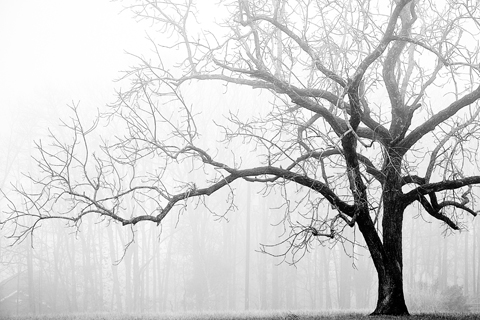
There are a number of things you can do to help your trees survive the winter when they go dormant. Almost everything about winter; the ground freezing, the heat of daytime followed by freezing nights, snow and ice storms can all damage your tree.
Trees are known for their ability to survive through the winter and then spring back to life during the spring. Today we’ll be taking a look at just how trees are able to do this, and we’ll learn something about nature as we go.
Let’s start by looking at dormancy and some of the measures 72 Tree and you can take to help your trees survive the coldest months.
Dormancy in Deciduous Trees
Dormancy is one of the coolest tricks Mother Nature knows. This is when a tree stops producing food during the winter and no longer needs the photosynthesis process or the leaves involved in it. So leaves have to be removed to conserve energy. Deciduous trees produce a chemical called abscisic acid (ABA) in the terminal buds that connect leaves, telling leaves it’s time for them to go.
ABA prevents both deciduous and coniferous trees from growing. This impeded growth is another part of the dormancy process, further reducing how much energy the tree consumes. As the tree enters a conservation state, the metabolism of the tree slows down; using the energy from stored food slowly to maintain vital functions.
Winter Tree Care
Pruning – You should wait until dormancy to prune your tree, when you aren’t likely to damage new growth. Late season growth is particularly at risk from pruning, as it hasn’t had the time to prepare for winter months. Ice crystals may form within new growth and rupture cell walls. If they aren’t pruned properly, they are likely to die off during the spring.
Visit here for more pruning tips and instructions.
Mulching – Winter drought is a problem caused by a tree shrub or plant losing more moisture than can be absorbed. While you aren’t able to control the weather, you have some influence of the effects of it. Putting a thick layer of organic mulch down before winter temperatures set in helps to insulate the roots. The mulch also prevents runoff and moisture loss, benefiting the overall health and hydration of the tree.
Please note that trees don’t freeze entirely, even in a dormant state. Looking at the tree shows you they prepare on the cellular levels. It sounds incredible, but much of the work a tree does to survive winter is happening under the bark inside the tree.
Remove Build-up of Ice and Snow – It’s likely that you might see snow build up on your tree or cling to the branches of it following some bad winter weather. It’s important that you leave the snow be and don’t shake it off. There’s a good chance that the branches have frozen solid and become brittle. Shaking them could damage the tree or even cause these limbs to break off and fall, which is a serious hazard. If you find yourself in this situation then call in a tree professional to evaluate the situation. They will be able to advise the best course of action to take.
Trees Spring Into Life Following Dormancy
Trees will start springing back to life as the days get longer and the temperatures get warmer. If you took care of them properly, then you’re in for another year of beauty and shade provided by a healthy tree. Taking care of them, by the way, means doing absolutely nothing and letting nature take its course. After taking care of the seasonal pruning, you’ll have done enough to protect your tree. Trust the natural survival mechanisms of your tree to handle everything else.
Your trees are often stressed during winter. Knowing ways to lessen the impact is helpful. Learn these preventative tree stress methods to give your trees a greater chance at prolonged health and life. 72tree.com/winter-tree-stress-prevention-and-protection-tips/
Notice: Undefined variable: page in /home/vrxdg1855sn3/public_html/wp-content/themes/72tree/content.php on line 15
Notice: Trying to get property 'ID' of non-object in /home/vrxdg1855sn3/public_html/wp-content/themes/72tree/content.php on line 15
Assessing Tree Damage Post Hurricane
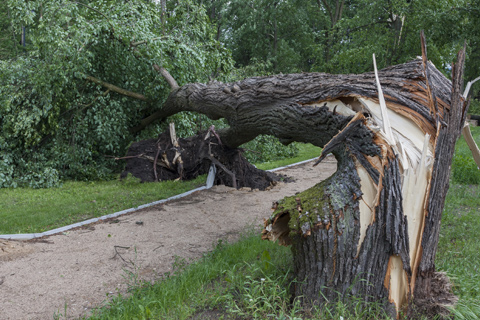 The very random weather condition in Georgia can be tough on trees. 72tree.com deals in disaster relief, so we often see the impact of weather on trees. Regardless of whether it’s a hurricane, ice storm, hail, tropical storm or strong winds, immediately after the weather event, caution and care should be taken to treat and heal the affected trees immediately.
The very random weather condition in Georgia can be tough on trees. 72tree.com deals in disaster relief, so we often see the impact of weather on trees. Regardless of whether it’s a hurricane, ice storm, hail, tropical storm or strong winds, immediately after the weather event, caution and care should be taken to treat and heal the affected trees immediately.
Trees in native stands are said to sustain fewer wounds and decay when compared to their counterparts in the urban and suburban environments. Severe storms like hurricanes and torrential downpour in addition to debris and structures can causes trees to sustain severe and fatal injuries.
Humans to a large extent contribute to these injuries – albeit by accident, such as construction equipment, vehicles, bumping into the tree trunks, lawn mowers, improper pruning and surface roots. Other natural events like severe storms can cause devastating injuries, crown damage and on some occasions, total destruction of the trunk.
Evaluating Tree Damages
Often times, trees easily recover from severe damages arising from harsh storms. Before felling trees that can be saved, use the guide below to help you diagnose them;
Missing Limbs – The more severe the damage to the tree limb is, the lesser the chances of recovery. If a majority of the branches are gone, removal should be considered as the tree has a very little chance of pulling through.
Is the Crown Intact? – If the crown of the tree has a significant portion of its branches affected, removal should be pondered as it may not produce enough to last another season. The crown extends from the tree trunk in the canopy region.
Multiple Missing Limbs – Normally, the remaining limbs are expected to grow rapidly to replace the missing foliage. Check to see that the branches are in the right place, as they will help in giving the tree a fuller appearance.
Assessing Trunk Wounds and Their Treatment
Trunk wounds that pierce the bark of the tree will damage its cambium layer – a thin layer of vascular tissue, which helps in conveying mineral and nutrients. In the event that there is a wound on the trunk, carefully, the injured bark should be removed, what should remain is a healthy bark that is healthy and firmer on the tree.
Decay-causing fungi can initialize a decay process when a wound occurs. Trees have a special defense system – the wood around the wound produces a special compound in the wood cells that will obstruct and segregate the affected part – this process is known as compartmentalization.
To hasten the healing process, branches affected by the storm should be properly pruned. 72 Tree warns to ensure that you do not prune directly against the trunk as flush cuts can cause widespread decay.
Tree Removal as a Last Resort
Tree removal is often at the bottom of the list, but some circumstances can justify the action. Furthermore, our Arborist treesaregood.org/findanarborist/findanarborist/id/169107 can help you ascertain if a tree needs to be removed or not.
However, before a decision can be reached, these factors should be taken into consideration:
• The age
• The species
• Type of soil and saturation
• The tree’s capacity to sprout and recover
• The tree’s position (level or sloped terrain)
Once you have reached a decision, arrange a meeting with a professional tree service to treat or have the tree removed. In conjunction with an arborist, tree professionals have the needed skill, equipment and experience to safely remove a tree in the safest possible manner.
